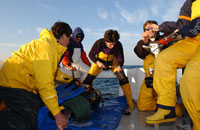TAG is in Italia! TAG scientist Dr. Andy Seitz, with the generous assistance, support and hospitality of Daniele Crepaldi, is on the trail of Italian bluefin, or tonno rosso to the locals. The expedition began in the city of Imperia on the Ligurian Sea. The first day was windy so they toured the city. They fished the next three days and saw nothing. Just as they decided that there were no fish in the area and it started to pour rain, they caught a small bluefin of 103 cm (~40 in). Because it was too small to satellite tag, they tagged it with one of the new LAT tags - a more compact archival tag.
They are now in Livorno on the southern Ligurian Sea in the Tuscany region, where they will fish for a couple of days before heading over to the Adriatic Sea.
Wednesday, September 23, 2009
Wednesday, September 16, 2009
Tuna Tagging in New Zealand

After two weeks of bad weather, Tag-A-Giant finally made it out on the water. We left Greymouth September 4th for a 48 hour trip under blue skies and calm seas aboard Reel Passion captained by Mark Hoare and mates Paul Eyers and Craig Taylor. Within 15 minutes of arriving at the fishing ground, Reel Passion had her first tuna bite of the tagging season. After an hour and forty minute fight, 16 year old Shyloh Knight caught his first Pacific Bluefin tuna weighing in at 278.6 kg and 258 cm. We worked hard to catch some more and get our 9 satellite tags in the water, but we were unsuccessful. The TAG team moved up to Westport to give it another shot aboard the Te Ariki Nui captained by Jason Wootton...hopefully they will be snapping!
(Posted by Randy Kochevar for Robbie Schallert)
Tuesday, September 15, 2009
Monitoring tuna ranches




TAG-A-Giant descended upon Ensenada Mexico in mid-August to install an acoustic monitoring station in collaboration with Maricultura del Norte. The TAG team led by Dr. Barbara Block, Robbie Schallert, Luis Rodriguez and Dane Klinger successfully implanted twelve acoustic tags inside captured Pacific Bluefin tuna. The fish were then released back into their grow pen, where they will be monitored remotely from Stanford University's Hopkins Marine Station in Pacific Grove, CA. The internal tags measure the tuna body temperature and transmit the data to a receiver mounted on the outside of the cage. The receiver then relays the information to a satellite overhead, which downloads the information to scientists.
Subscribe to:
Comments (Atom)



